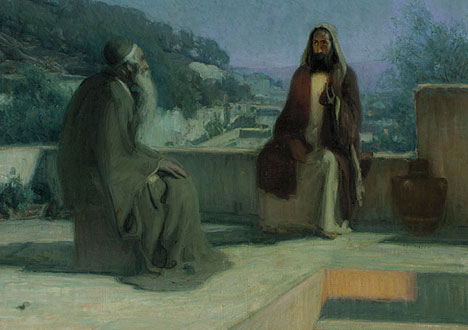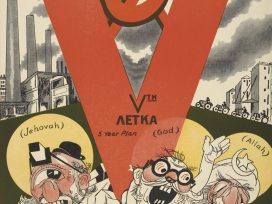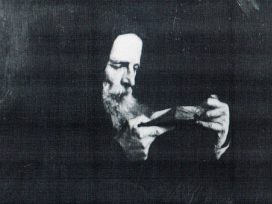“Throw the sexagenarians off the bridge!” Thus the ancient Roman slogan: Sexagenarios da ponte! One would think that this radical “solution” to the problem of old age was abandoned with the spread of Christianity, but it has survived deep down in the European psyche to a worrying extent. During the 1960s, among the young insurgents of our continent’s great capitals there spread the exhortation “Don’t trust anyone over thirty!”; after two thousand years of Christianity, the negative portrait of old age was still at hand. To be fair, the scriptural basis for a Christian apologia for old age is not that encouraging either. Jesus taught us essential things – how to pray, how to act, how to love our neighbours, how to suffer and how to die –, but he did not get the chance to set an example in old age. His life ended at 33. The twelve apostles were aged between roughly 18 (Saint John the Evangelist) and 32 (Saint Peter) when their teacher left them. In contrast to the “gerontocracy” of the Old Testament patriarchs, the whole of the New Testament radiates a certain energy, a certain youthful freshness. Besides, in the scriptural world, old age is not the ideal age for spiritual apotheosis. The age of fulfilment, of faith and mature knowledge is the age reached by Jesus, the age of manhood, of perfection as measured against Christ’s example (Ephesians 4:13: “to a perfect man, to the measure of the stature of the fullness of Christ”).
Of the 25 instances in which the word presbyteros is used in the four Gospels, the majority of them do not refer to age but to a public office, and a questionable one at that from the perspective of Christ’s destiny. The elders are part of the leadership of the Jewish community, members of the Sanhedrin (cf. Mark 8:31: presbyteroi, archiereis, grammateis), who are thus responsible for charging and convicting Jesus. In Matthew 15:2, the elders are portrayed as authoritarian representatives of the Jewish tradition (paradosis ton presbyteron), that is, the tradition “of men” (paradosis ton anthropon, Mark 7:3,5,8) who had disobeyed God’s command. Only in Luke’s Gospel, in two out of the five occurrences of the same word, old age has more neutral connotations: some “elders of the Jews” are sent to Jesus to ask him to cure the centurion’s servant (7:3), while in chapter 15 verse 25 the term provides a strictly temporal dimension to the prodigal son’s brother: he is the “older” brother. The only reference to the elders in John 8:9 is significantly ambiguous: they are the first ones to hurriedly leave the scene when Jesus calls on those who consider themselves to be without sin to throw a stone at the adulterous woman. In other words, the elders are the most heavily laden with sins and full of repentance.
In the Acts, Revelation, Pauline Epistles and General Epistles, while the term retains its negative meaning from the synoptic Gospels, it also appears frequently with the meaning of “priests” of the new community. Once again, the emphasis is laid on one’s office rather than age, although the two can be conflated as in the case of Saint John the Apostle who calls himself “the Elder” (2 John 1:1 and 3 John 1:1). Office and age are, together, an argument of authority as in 1 Peter 5:5: “submit yourselves unto the elder.” Thanks to its authority, old age is the best qualification for carrying a credible message (presbeia can also mean “delegation” cf. Luke 14:32 and 19:14). The apostles are Christ’s ambassadors, they bring the good news of His Resurrection. “An ambassador in chains” (presbeuo en alysei) is how Saint Paul speaks of himself (Ephesians 6:20) – the “chains” of persecution but also, perhaps, of old age itself. Those laden with years are holders of an office which, on the other hand, does not exempt them from a constant effort at spiritual improvement. Although they are teachers, they always have something to learn (“When it comes to learning something that is necessary”, says Saint Augustine, “we are never too old…”). That is why Saint Paul believes that he has to advise not only young people but the elderly too: “that the older men be sober, reverent, temperate, sound in faith, in love, in patience; the older women likewise, that they be reverent in behaviour, not slanderers, not given to much wine, teachers of good things” (Titus 2:2-3).
Thus, two roles are outlined for the aged of the New Testament world: that of a guide and the underlying one of an intermediary. Those who reach old age do not honour it as they should if they are not ready to take on both roles: they will be, in the name of what they have accumulated, intelligent advisers, kind teachers and experienced intermediaries between the contingent world and the “hereafter”, between certainty and mystery, between life and death, between death and resurrection. However, the texts also add another dimension to old age, such that a direct connection to God the Alive is maintained: the creative dimension, fertility. Following the example of Abraham and Sarah, two other elderly couples manage, thanks to providential intervention, to have children when biological limitations normally preclude doing so: Zacharias and Elizabeth, the parents of Saint
John the Baptist, and Joachim and Anne, the parents of Virgin Mary. Such events suspend the received definition of old age. There is a place for miracles after all: procreating elders find themselves in immediate proximity to the Creator as they themselves become creators, life-givers, having been chosen by the supreme Father to mirror the founding image of paternity on Earth.
Thus, the old age of the New Testament can have negative connotations as the symbol of an authority unreceptive to Christ’s new message, the embodiment of a sclerotic tradition, a blockage, but also positive connotations as a legitimate office, an endeavour seeking to serve, a distinguished authority.
European culture has inherited this “duplicity” and has broadly produced two types of discourse on old age. One is full of pathos, sombre, with a masochistic undertone, by the end of which one feels irreversibly condemned to powerlessness, pain and death; old age is the painful anteroom of one’s end, an ever expanding assortment of all kinds of degradation, the ultimate limit of which is the opaqueness of nothingness. However, there is also a discourse on old age oriented toward euphoria, whereby old age has an irreducible charm: a subtle mixture of wisdom, authority and virtue, a good opportunity to regain, by way of compensation, a lifestyle which is more pure, free of bodily interferences, whilst full of the benefits of long experience. All of old age’s “natural” losses are coupled with auspicious “gains”. In short, old age comes as a well-deserved break and a chance to start again from a perspective other than that of earthly determinism.
It would be a mistake to attribute the strictly tonic version of the discourse to Christianity. The pious image of holy old age haloed with enlightenment and ready to render its soul into the welcoming hands of the Creator is just a commonplace of Sunday didacticism, suffocated by unconvincing rosiness and conventional “idealism”. It is enough to do a quick inventory of the texts on this subject within the Christian Church tradition to gain a somewhat more realistic perspective on things. This is what Georges Minois tried to do in his well-known History of Old Age. Here is one of his conclusions: “In fact, for the Church there was no specific problem of the elderly […] Christian writers were manifestly not interested in the problem of old age. Old people are virtually absent from their works and one has to read hundreds of volumes in order to gather a bit of material on the subject.
Bishops studied the atemporal human species, the ageless human being and its relationship with God.” Indeed, Christian writers deal with either significant analogies between world ages and human ages, or the symbolism of numbers (seven or six life stages, 24 elders in the text of Revelation, etc.), or the decrepit image of those reaching the end of their lives. Georges Minois brings together the rather depressing thoughts of Saints John Chrysostom, Augustine, Jerome, Ephrem the Syrian, Cyril of Alexandria on the disfiguring shortcomings of old age. It is maintained that the number of vices increases with the number of years. With a penchant for lying, presuming and procrastinating, morose, lazy, lascivious, mean, selfish, bad-tempered and greedy old people illustrate the effects of original sin. They are veritable metaphors of evil. Old age is fundamentally perceived as a disease, a punishment, and its representatives stand alongside a medley of beggars, the infirm and the disinherited. This leads Georges Minois to conclude that “Christian writers have a pessimistic view of
old age” and thus perpetuate the Old Testament and Greco-Roman worldview. So much so that patristic literature mentions one episode in which the devil, in order to pursue its corrupting strategies, cunningly disguises itself as an old monk. The “champion” of demythologizing old age seems to be Saint John Chrysostom. As for the sympathy shown by Saint Gregory the Great to the aged (“I have always had a weakness for old people’s conversations…”), this is the exception that confirms the rule.
However, in his Homilies on Numbers, Origen too knew how to appreciate the qualities of old age: the purity of the heart, the sincerity of the soul, the superior understanding of things. As for the continuation of the Greco-Roman tradition, it too has to be seen in a more nuanced light. Cicero’s famous book on old age is not at all a sombre lamentatio. Its message is, on the contrary, a consoling if not an encouraging one. Old age is not “odiosa“, at least no more than the other ages. In moribus est culpa, non in aetate. It is a fact that we all want to get old, only to complain once we reach old age.
And yet all the great shortcomings of getting old (diminishing active life, frail body, suspended pleasures and approaching death), confer certain advantages upon those who know how to enjoy the benefits of a contemplative life open toward other pleasures and other types of activity. As for death, it can come at any age and is in fact only a down payment for the continuation of life.
One almost wonders what Christianity has added to Roman writers’ reflections on old age. The prompt, handy answer would be a much greater emphasis on transcendence. But such an answer – otherwise valid – merely reiterates the question. In other words, the issue is: what does the dimension of transcendence bring to a better understanding and use of old age? I shall attempt below a brief answer.
1. Opening up toward a horizon which goes beyond the horizon of earthly immediacy implies a new experience of time and, consequently, a reorientation of spiritual life before death. Chronological time is coupled with eschatological time, the time beyond time, the time of the “Kingdom”. For an old person, today ceases to be a more or less glorious culmination of yesterday and becomes the inaugural moment of an otherworldly tomorrow”. The space of the present ceases to be the space of “adapting” to contingent limits and refashions itself as a space of waiting and hoping. In this space, the old person is no longer an example of the imminent “end”, nor a metaphor for it, but a “beginner”, the
experimenter of a new “start” in a race with a transfinite end. “The end of the road” as the end of a journey is suspended and redefined as a “stage”. “Of all the fruits of the world, the human being is the only one that never ripens”, said Constantin Noica, a Romanian philosopher whose pupil I was. That is, it is the only one that can never be considered “finished”; the “picking” has no known date, it cannot be anticipated at a human level; nobody knows the hour. And this taxing indetermination imposes only one exigency: always to be ready, at every moment. Old age is the spiritual technique of waiting actively, confidently, patiently while oriented toward a certain but temporally undefined goal.
If one can speak of old age as the preamble to “closure”, then, from a Christian perspective, one must also immediately add – using an expression coined by the same Romanian philosopher – that it is a “closure that opens”, a limit which “unloads itself”, fulfils itself through nonlimitation. An ordinary old person living only in chronological time will try, in his or her vanity, to “keep up appearances”.
However, the eschatological horizon places everything beyond appearances. That is why all the studies about old age – and there are very many of them – carried out from a phenomenological, sociological, anthropological, medical, etc. perspective can be useful, however, they treat old age as a “closure that closes”, as the opaque ceiling of an asylum, the only purpose of which is to deposit unusable existential residues.
All the parables about waiting (The Servant, The Thief, The Ten Virgins, The Faithful Servants, The Doorkeeper, The Seed Growing Secretly) can be read as parables of the gap separating earthly life from the episode of individual death or from that of the Judgement and the Kingdom. This is the gap that old age excels above all else in bridging. Every age awaits the next age and gets ready for it. Only old age awaits something else – not another age but another state, another status, another life. In other words, old age is, more than any other age, characterized by what Kierkegaard called the mystery of “bilocation”. An old person is simultaneously on two different planes: here and beyond, now and in the future, on Earth and in heaven. One could say that whoever achieves this happy feat early on,
whether during their youth or maturity, has acquired the virtue of old age on time. This is, among other things, the virtue of eliminating in a timely fashion anything that anticipates death, from the first years of one’s active life onward: unnecessary experiences, obsessions, verbal and behavioural stereotypes, intellectual (and physical) sedentariness – in short, anything that is “ready-made” in the repertoire of daily gestures, emotions and thoughts. Once the immanence of death has been vanquished, one escapes the monotony of one’s earthly location: one changes one’s place, resituates oneself in another place, topos atopos, resettles in an old age other than the one that ends in death.
Placing oneself outside chronological time and within the psychology of waiting changes the
metabolism of one’s temporal existence and, in general, the regime of one’s actions. Paradoxically, against the diffuse, atemporal background of transcendence, immanent acts become more precise. They leave the circumstantial, the strictly pragmatic calculations and the impatience for a prompt reward in order to pursue a project which goes beyond them. They are no longer daily “tasks” but instances of dedication, integration into a higher order, the ability to “listen”. In a word: ascesis. Given that one does not know when exactly one will find oneself outside of time, one does things “on time” but in a disinterested way, just as a wise servant obeys the absent master and feeds the other servants “on time” (en kairo).
Efficiency does not result from focusing on and taking an active interest in the mechanics of one’s actions, but from an unmistakable feeling of “urgency”. Present time becomes an
“opportunity” (kairos), and every single opportunity must be met with lucidity and made use of, with a view to achieving something long-term as well as beyond time. When lived well, old age rethinks everything – including its shortcomings, the approaching of death, loneliness, being an outsider – as an unusual “raw matter” waiting to be remoulded. There thus appear new issues to reflect on, new attempts, decisive ways to reassess one’s self. The “quality” of one’s actions changes radically: they get closer to the event, the unique gesture, the intense simultaneity of a point free from the predictability of linearity. Besides, time is understood less and less as a succession of moments: a moment is more important than its passing. Patience (hupomone) and confidence replace rushing into things. A “novelty” can occur at any time, just like the late conversion of the Roman rhetor Marius Victorinus. The reward too “comes on time” but timelessly, following rules other than the conventional ones, just like the “unfair” remuneration of the workers who, having only started work
near the end of the working day, are paid the same amount as those who started at dawn (Matthew 20:1-16).
2. Old age is simultaneously coupled with transcendence and the origin of time. A short philological digression will help us understand this point. In Germanic languages the same word – the English “old” and the German “alt” – can refer to both something that is not new and to an old person. Hence its ambiguity: it can mean the decrepitude associated with the approach of death, but also the value added to something which has lasted a long time. The French language, and Latin languages in general, are less prone to this ambiguity. Take the distinction made in French, for example, between “vieux” and “ancien”. “Old” clothes, something which has gotten old can mean something which has expired, has gone out of use, while an “old wine”, “old friends”, “old manuscripts” are, on the contrary, often of inestimable value. Similarly, old age can be the age of disease and loss, but also the age of wisdom, experience and prestige. The old people in an asylum are sad. The old people of a city are imposing. Thus, old age can be regal as well as a form of slavery. In his book The Force of Character: And the Lasting Life, an old American academic of Jungian extraction, James Hillman, traced the German etymology of old age. And this is what he found: “‘Old’ is itself a very old word, supposedly deriving from an Indo-European root that means ‘to nourish’. Tracing the word into Gothic, Old Norse, and Old English, we find that something ‘old’ is fully nourished, grown up, matured. […] The world nourishes when we feel its oldness. […] the very word “world” was once spelled wereald, weorold: this nourishing place, so full of eald. It is as if “old” were hidden inside “world” much as the Gnostics’ Sophia and the Kabbalists’ Shekhinah were the soul concealed within the created world. […] Aging opens the door to ‘old’ […] Can we know the world’s oldness […] until we are ourselves old? That the old are burdened with wisdom means that they know the ways of the
world because they are old, as it is. They share the same state of being.” Thus, old age is
consubstantial with the world in a more profound sense than juvenile “worldliness”. It carries the weight of the whole of Creation and, through it, radiates transindividually. An old person in touch with the originary and the transcendental rises above themselves. One is a nourishing instance, a witness, an allegory of the “beginnings”. It is not by accident that The Shepherd of Hermas compares the Church itself to an old woman even though, in the second century, it was in full bloom. Compared to the other creations, it was “old” because it had been created before them.
3. Placed between contingency and transcendence, an old man is a bridge – pontifex –, an expert and an “agent” of crossing over, a guide. Thus, we see the magisterial dimension of his age, his role as a spiritual father: abba. Thanks to the “Desert Fathers” of the early Christian centuries, spiritual paternity has become an institution. “Old men” teach through their simple presence. They do not place their pupils on the “sand” of their lectures but on the “rock” of their actions. The pupil merely has to do what the “old man” (as in the case of Abba Theodore) does. To learn from his silence (as in the case of Abba Pambo). The mere fact of accompanying a guide and accepting his authority brings with it the acceptance of a status which is the very status of a believer: huiothesia, belief is a way of allowing oneself to be “adopted”, of submitting to godly “paternity”. Thus, old age can arouse in those around it the vocation of affiliation, of filial attachment which constitutes the essential step in any
spiritual engagement. Through one’s confessor one has the chance to attempt to start communicating with the heavenly Father. Obviously, an old person’s ability to be an intermediary and a model implies increased responsibility, as well as the risk of a severe final judgement in case of failure (cf. James 3:1). The authority of old age is therefore bound to be a humble kind of authority, which seeks to serve without enforcing any kind of hierarchy.
At this point we must say that the Christian worldview does not in any way encourage the
exceptionalism of old age. This may be one of its essential contributions to a realistic understanding of elderliness, which is not put on a pedestal, is not idolized as an absolute guarantee for finding one’s place. After all, it is not an inherently superior “age”, the result of a strictly quantitative accumulation, nor is it a “rank”, a “senior position”, but a qualification. And this qualification can also occur at other stages in one’s life. Here is a passage from Origen (Homilies on Joshua): “In Scripture, the word ‘old’ or ‘old man’ is not attributed by virtue of old age but in order to honour a mature judgement and a life full of gravity, especially when to ‘old’ one adds the expression ‘full of days’.” “Full of days” is never
used in relation to those who live very long but morally ambiguous lives, like Adam, Noah or
Methuselah. The first time the phrase is used, it is with reference to Abraham, whose life is shorter than that of all of the former. In his commentary on the Gospel According to Saint Luke, Saint Ambrose too talks about “an old age which is venerable not because of its duration and is not calculated in number of years”. Thus, grey hair is indicative of purity and wisdom only if, as Saint John Chrysostom says, it is first indicative of the inner self. Saint Augustine says the same thing: old age is not perfect in and of itself, but only if it equates to wisdom which, in turn, does not necessarily depend on physical age. It is also possible to speak of a significant overlap of ages: there are children who are old thanks to their morals, just as there are old persons who retain a certain childlike innocence (Saint Ambrose’s commentary on the Gospel According to Saint Luke). Finally, a reversal of roles in the “father-pupil” relationship is also possible. Thus, one remembers the story of an “old
man” who, in a bout of anger, chases his disciple out of his cell, only to tell him two days later, after having found him patiently waiting outside his door: “Come, enter, from now on you shall be the old man and father and I the young man and pupil”.
Old age is not, in and of itself, a form of paradise. It would be illusory – and, I would say, unchristian – to euphorically ignore the shortcomings, sufferings, human drama which any old person, however sprightly, experiences sooner or later. One cannot hypocritically see decrepitude as a blessing. One cannot fade intellectually and physically without feeling sad. Trying to understand these “accidents” in an edifying way is to get close to a very old, complicated and risky question which is the question of evil. However, the solutions put forward by a Christian old age are different: patience, prayer and, however audacious it may seem, humour. Old age is privileged insofar as it is the best “opportunity” for unresigned patience, for converting every gesture or thought into constant prayer and restorative
laughter. We are obviously not talking here about the laughter of unashamedness, of triviality, of worldly derision, but about the “eschatological” laughter, the one mentioned in the Gospel According to Saint Luke (6:21): “Blessed are you who weep now, for you shall laugh.” It is the laughter contained in Isaac’s name, the laughter of his parents, Abraham and Sarah, which finds itself on the dividing line between perplexity and hope, the laughter of old people intersecting with the laughter of God. It is the “laugher of the wise” (sophronounton ho gelos) which Clement of Alexandria deals with in the fifth chapter of the second book of his Paedagogus: a “measured”, “educated” laughter which is closer to a harmonious smile (meidiama) than to foolish and boisterous cheerfulness, or the dourness
of the irremediably sullen (suthropon).

Henry Ossawa Tanner (1859-1937), 1899, 85.6 x 100.3 cm. Pennsylvania Academy of the Fine Arts. Source: Wikimedia
Allow me to have reservations about the expression “the art of aging”. It suggests the pretentiousness of a “prescriber”, a cure which can be immediately applied, provided there is a minimum of will power. However, faith is not a “procedure” and Christian life, irrespective of age, is not a linear, predictable chain of ready-made gestures and efficient “techniques”. Its raw matter is individual freedom, compassion and divine grace. The fuel of Christian old age is, in this sense, the power to begin again, to advance, as Saint Gregory of Nyssa says, “from beginning to beginning” until one reaches the “youth without old age” of the hereafter. “How can a man be born when he is old?” (geron) (John 3:4) is the question that Nicodemus, and with him all the old people of the world, asks Jesus. And Jesus’s answer is: “You must be born from above” (anothen) (John 3:7). This is, according to the Christian worldview, the mission of old age: to achieve a symmetrical replica of bodily birth.
The mission of an anagogic leap, of a vertical launch, of a brave effort whereby the soul attempts to find its origin. Trampling on old age by old age following the example of the One who was resurrected “trampling on death by death”…







